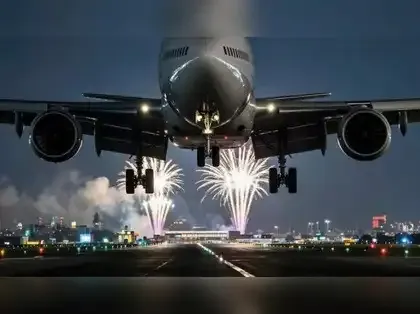When lights flickered on at Navi Mumbai's new airport last week, it marked India's bid to join global aviation hubs like Dubai and Singapore. But if Indian aviation wants to achieve that dream, India must first help its carriers fly shoulder to shoulder with Emirates and Singapore Airlines.
Here's why Indian carriers lag:
Emirates pays no local taxes on fuel, enjoys seamless international leasing and financing, and coordinates network planning with government tourism and trade policy.
Singapore Airlines benefits from predictable regulation, zero VAT on ATF, and deep ties between aviation policy and national logistics planning.
India has built world-class airports but left its airlines lagging. Infrastructure came first, competitiveness later - and it shows in the numbers.
Fuel economics
ATF accounts for roughly 40% of operating cost for Indian carriers - among the highest globally. In Dubai, aviation fuel is treated as a zero-tax export input. In Singapore, it's exempt from VAT and linked to international crude benchmarks. In India, ATF price is opaque, revised fortnightly, and varies state by state.
Another handicap is the absence of a linkage between Indian ATF prices and global crude indices. Indian OMCs set domestic ATF rates independently. In contrast, Singaporean and Emirati carriers hedge directly against Brent or Jet Kero indices, stabilising their cost structures and reducing exposure to volatility.
Airport and ancillary charges
Landing, parking and user fees at India's metro airports are among the highest in Asia.
Fleet finance
Around 80% of India's commercial aircraft are leased from foreign lessors. Lease rentals, insurance and maintenance reserves $3 bn each year. Indian banks rarely finance aircraft assets directly. Maintenance and overhaul work, too, is largely outsourced abroad.
Every passenger flying from India to Europe via Dubai creates more value for the Emirates ecosystem than for India. Fuelling, maintenance, crew bases and financial transactions all occur there. Over time, this builds jobs, investment and innovation.
If India's airlines were strengthened, they could reverse this cycle.
Bring ATF under GST or at least set a uniform cap on state VAT at 4-5%. Allow input tax credits so airlines can recover part of their costs. Link ATF pricing transparently to international benchmarks to enable hedging. Such reforms could reduce effective fuel costs by as much as one-third, freeing up capital for expansion and fleet modernisation. Equally important is establishing a uniform ATF pricing system across airports.
India has begun building an aviation finance hub through GIFT City. Since 2021, International Financial Services Centres Authority (IFSCA) has allowed aircraft, engine and component leasing from its jurisdiction, with a 10-yr tax holiday and duty exemptions.
But most current lessors are foreign-owned entities that use GIFT as their booking location. Funds still flow to Dublin or Singapore, and the deeper value creation remains abroad.
If India wants GIFT City to maintain value, it must encourage local participation, not just register contracts domestically. Indian banks, insurers and fund managers need regulatory assurance to co-finance leases and manage exposures.
A small portion of the current $3 bn annual outflow could be redirected back into India if domestic capital and services become involved. Over 5 years, that's $15 bn in lease payments that could be partly kept onshore.
For this, GIFT must evolve from a tax- neutral offshore park to a real financial ecosystem - complete with Cape Town-compliant repossession certainty, rupee-denominated leases, and smooth linkages with RBI, DGCA and customs. Only then will aircraft financing shift from 'registered in India, paid abroad' to 'owned and managed in India'.
Consider how Emirates built its hub model. From the start, Dubai's leadership saw aviation not as a tax source but as a strategic growth lever. They ensured zero fuel tax, built dedicated MRO capacity, and used the airline to drive tourism, cargo and employment. Emirates now accounts for over 20% of Dubai's GDP, with each flight feeding the city's economy.
To break that cycle, India needs to:
These aren't mere tweaks - they're the foundation of an aviation nation. A strong airline industry creates skilled jobs, boosts trade and tourism, supports Make in India aerospace, and strengthens strategic connectivity. Every extra international flight by an Indian carrier keeps value in rupees, attracts tourists, expands export freight and links regional cities globally - delivering systemic economic dividends.
The debate over India's aviation future cannot be reduced to user fees and tax collection. It must be about strategic capability - power to connect, resilience to sustain shocks and competitiveness to anchor Asia's traffic flows.
Navi Mumbai's opening should mark not just the start of new flights but the beginning of a new aviation philosophy.
Here's why Indian carriers lag:
Emirates pays no local taxes on fuel, enjoys seamless international leasing and financing, and coordinates network planning with government tourism and trade policy.
Singapore Airlines benefits from predictable regulation, zero VAT on ATF, and deep ties between aviation policy and national logistics planning.
India has built world-class airports but left its airlines lagging. Infrastructure came first, competitiveness later - and it shows in the numbers.
Fuel economics
ATF accounts for roughly 40% of operating cost for Indian carriers - among the highest globally. In Dubai, aviation fuel is treated as a zero-tax export input. In Singapore, it's exempt from VAT and linked to international crude benchmarks. In India, ATF price is opaque, revised fortnightly, and varies state by state.
Another handicap is the absence of a linkage between Indian ATF prices and global crude indices. Indian OMCs set domestic ATF rates independently. In contrast, Singaporean and Emirati carriers hedge directly against Brent or Jet Kero indices, stabilising their cost structures and reducing exposure to volatility.
Airport and ancillary charges
Landing, parking and user fees at India's metro airports are among the highest in Asia.
Fleet finance
Around 80% of India's commercial aircraft are leased from foreign lessors. Lease rentals, insurance and maintenance reserves $3 bn each year. Indian banks rarely finance aircraft assets directly. Maintenance and overhaul work, too, is largely outsourced abroad.
Every passenger flying from India to Europe via Dubai creates more value for the Emirates ecosystem than for India. Fuelling, maintenance, crew bases and financial transactions all occur there. Over time, this builds jobs, investment and innovation.
If India's airlines were strengthened, they could reverse this cycle.
Bring ATF under GST or at least set a uniform cap on state VAT at 4-5%. Allow input tax credits so airlines can recover part of their costs. Link ATF pricing transparently to international benchmarks to enable hedging. Such reforms could reduce effective fuel costs by as much as one-third, freeing up capital for expansion and fleet modernisation. Equally important is establishing a uniform ATF pricing system across airports.
India has begun building an aviation finance hub through GIFT City. Since 2021, International Financial Services Centres Authority (IFSCA) has allowed aircraft, engine and component leasing from its jurisdiction, with a 10-yr tax holiday and duty exemptions.
But most current lessors are foreign-owned entities that use GIFT as their booking location. Funds still flow to Dublin or Singapore, and the deeper value creation remains abroad.
If India wants GIFT City to maintain value, it must encourage local participation, not just register contracts domestically. Indian banks, insurers and fund managers need regulatory assurance to co-finance leases and manage exposures.
A small portion of the current $3 bn annual outflow could be redirected back into India if domestic capital and services become involved. Over 5 years, that's $15 bn in lease payments that could be partly kept onshore.
For this, GIFT must evolve from a tax- neutral offshore park to a real financial ecosystem - complete with Cape Town-compliant repossession certainty, rupee-denominated leases, and smooth linkages with RBI, DGCA and customs. Only then will aircraft financing shift from 'registered in India, paid abroad' to 'owned and managed in India'.
Consider how Emirates built its hub model. From the start, Dubai's leadership saw aviation not as a tax source but as a strategic growth lever. They ensured zero fuel tax, built dedicated MRO capacity, and used the airline to drive tourism, cargo and employment. Emirates now accounts for over 20% of Dubai's GDP, with each flight feeding the city's economy.
To break that cycle, India needs to:
- Rationalise ATF taxes by unifying them under GST or capping VAT uniformly.
- Link fuel pricing to global benchmarks for cost-effective hedging.
- Incentivise airlines to base fleets and develop connectivity rather than charging per landing.
- Develop onshore finance GIFT City access to domestic banking, enforce repossession and provide rupee financing.
- Strengthen MRO and training.
- Integrate logistics and customs.
- Ensure every Indian airport is within an hour of the city via fast rail, road or sea links.
These aren't mere tweaks - they're the foundation of an aviation nation. A strong airline industry creates skilled jobs, boosts trade and tourism, supports Make in India aerospace, and strengthens strategic connectivity. Every extra international flight by an Indian carrier keeps value in rupees, attracts tourists, expands export freight and links regional cities globally - delivering systemic economic dividends.
The debate over India's aviation future cannot be reduced to user fees and tax collection. It must be about strategic capability - power to connect, resilience to sustain shocks and competitiveness to anchor Asia's traffic flows.
Navi Mumbai's opening should mark not just the start of new flights but the beginning of a new aviation philosophy.
(Disclaimer: The opinions expressed in this column are that of the writer. The facts and opinions expressed here do not reflect the views of www.economictimes.com.)






V Shunmugam
Partner, MCQube